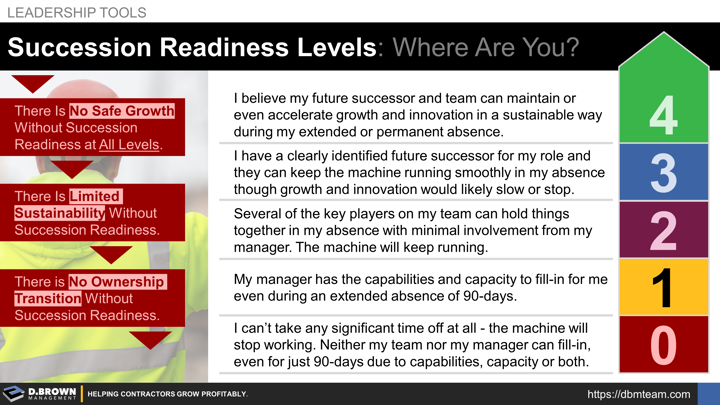Grab your org chart and your management team. Evaluate each supervisor or above role along with any critical specialty roles against this 0-4 scale, starting with the top leadership team. This is best done in groups of no larger than 10 people at a time.
THE EVALUATION
Imagine you are going on a 90-day, off-grid vacation. You are coming back but will be 100% out of contact for that period of time. Have people self-evaluate themselves first and discuss.
First of all, describe where you would go, who you would go with (if anyone), and why. This is an incredible opportunity to get to both dream big and get to know your team. There is far more value in answering this question than it appears on the surface. The more vividly you can answer this question, the closer you are getting to your "Perfect Life" and "Retirement Masterpiece" if that is in your near future.
Second, choose which level best describes where you are at in terms of succession readiness. This is not a contest. We've never seen a contractor with all 4's or all 0's. The important aspect is being pragmatic about the evaluation and having open discussions about how to best improve the succession readiness.
0. I can’t take any significant time off at all. The machine will stop working. Neither my team nor my manager can fill in, even for just 90 days due to capabilities, capacity, or both.
1. My manager has the capabilities and capacity to fill in for me even during an extended absence of 90 days.
2. Several of the key players on my team can hold things together in my absence with minimal involvement from my manager. The machine will keep running.
3. I have a clearly identified future successor for my role and they can keep the machine running smoothly in my absence though growth and innovation would likely slow or stop.
4. I believe my future successor and team can maintain or even accelerate growth and innovation in a sustainable way during my extended or permanent absence.
Work through your answers individually and put them in writing to help clarify your thinking. Be constructive but don't avoid saying the uncomfortable -- to yourself or to others. The time and discomfort that this exercise will take is minimal compared to the key-person risk of not being ready for succession at all levels.
“Nothing so sharpens the thought process as writing down one's arguments. Weaknesses overlooked in oral discussion become painfully obvious on the written page.” ― Hyman G. Rickover (Retired Admiral Considered "Father" of the Nuclear Navy)
THE DISCUSSION
- Meet together as a team.
- Share your answers and rationale with the team.
- Listen while others are sharing and ask clarification (not debate) questions to ensure common understanding.
- Discuss and debate any differences in perspectives.
THE ACTIONS
Prioritize the succession readiness risk for each person and start working on next steps for improvement. Readiness scores need context for prioritization. For example, a low succession readiness score for an owner in their mid-40s is a much lower priority than that same score for one of your three large project superintendents who is likely to retire in the next two years.
Principles of the 5D Process for Alignment and P.I.C.K. Prioritization applies.
Depending on your stage of growth, these groups will look very different. For a contactor in the first couple stages of growth, this is likely a one-on-one conversation with the owner and a trusted mentor or advisor that has a broader perspective. For a stage 5 contactor, this will likely be done in 2-3 groups involving the top three levels of management in the organization.
This evaluation is a critical part of your Talent Value Stream (TVS).
REMEMBER THAT...
- There is no "Safe Growth" without succession readiness at all levels.
- There is limited sustainability without succession readiness. Sooner or later, age will take all players off the playing field.
- There is no ownership transition without succession readiness within the leadership team. Outside sales without a strong internal management team for succession are rare - and rarely achieve the financial outcomes that any of the parties were hoping for.
Learn More
Mastering the planning and management of job role transitions will set your career and company apart. Whether it is transitioning from a craft to a Foreman role or succession at the ownership level, all job role transitions in the construction industry are challenging.
Careers, compensation, customers, projects, profits, and entire construction businesses are all impacted negatively when job role transitions are poorly planned and managed. Almost 3 hours of practical examples including 25+ additional resources (tools, books, training, and articles) to keep your career and company growing.
Access the additional resources and books referenced: 004 - Job Role Transitions in Construction (Intro)
An experienced and unbiased 3rd party can be invaluable for facilitating these discussions, including having some different ways to close some of the gaps. Often, role succession in the future looks very different than role succession in the past and that is where external experience can be valuable.
All relationships begin with a simple conversation - let's schedule time to talk.

